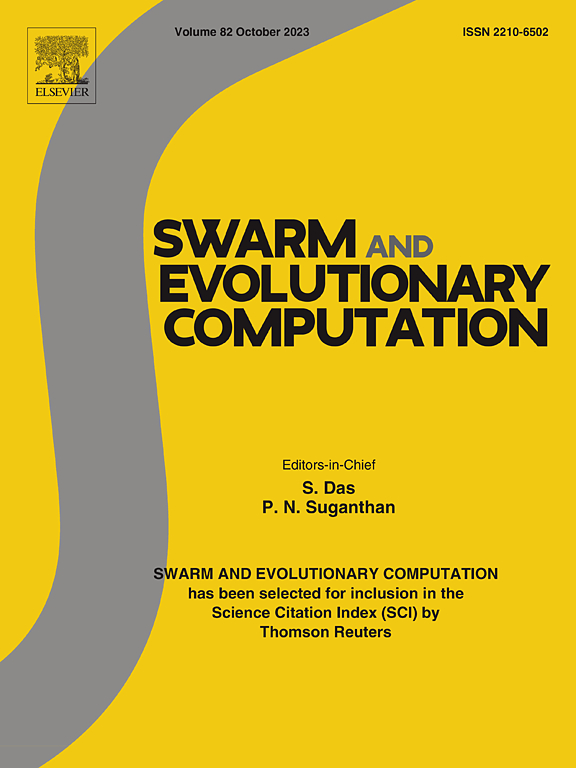增强无人机覆盖路径规划的强化学习集成进化算法
IF 8.5
1区 计算机科学
Q1 COMPUTER SCIENCE, ARTIFICIAL INTELLIGENCE
引用次数: 0
摘要
无人机(UAV)技术的快速发展使得其在各个行业的利用率越来越高。在搜索和救援(SAR)任务中,无人机在克服搜索环境中的机动性限制方面发挥着关键作用,特别是在海上行动等时间敏感的情况下。为了提高搜索任务的效率,研究了多架无人机在不规则形状搜索区域的覆盖路径规划问题。我们提出了一个新的CPP框架,包括两个主要阶段。在第一阶段,引入了一种结合强化学习的进化算法进行搜索区域分解,以最小化网格地图超出搜索区域的区域。其中,基于近端策略优化的粒子群算法(PPO-PSO)能够有效地适应复杂和不规则的形状。在第二阶段,建立了一个混合整数线性规划(MILP)模型,以最小化任务完成时间,同时保证多架无人机的避撞和高效任务分配。提出的方法通过15个实验场景进行了验证,包括真实的海洋环境,与现有方法相比,在管理不规则形状的搜索区域方面表现出优越的性能。本文章由计算机程序翻译,如有差异,请以英文原文为准。
Reinforcement learning-integrated evolutionary algorithm for enhanced unmanned aerial vehicle coverage path planning
The rapid development of unmanned aerial vehicle (UAV) technologies has led to their increased utilization across various industries. In search and rescue (SAR) missions, UAVs play a critical role in overcoming mobility constraints in search environments, particularly in time-sensitive situations such as maritime operations. To enhance the efficiency of search missions, this study addresses the Coverage Path Planning (CPP) problem for multiple UAVs in irregularly shaped search areas. We propose a novel CPP framework consisting of two main phases. In Phase 1, a reinforcement learning-integrated evolutionary algorithm is introduced for search area decomposition, aiming to minimize the area of the grid map exceeding the search area. Specifically, proximal policy optimization-based particle swarm optimization (PPO–PSO) is employed to effectively adapt to complex and irregular shapes. In Phase 2, a Mixed Integer Linear Programming (MILP) model is formulated to minimize mission completion time while ensuring collision avoidance and efficient task allocation for multiple UAVs. The proposed methodology was validated through 15 experimental scenarios, including real-world maritime environments, and demonstrated superior performance compared to existing methods in managing irregularly shaped search areas.
求助全文
通过发布文献求助,成功后即可免费获取论文全文。
去求助
来源期刊

Swarm and Evolutionary Computation
COMPUTER SCIENCE, ARTIFICIAL INTELLIGENCEC-COMPUTER SCIENCE, THEORY & METHODS
CiteScore
16.00
自引率
12.00%
发文量
169
期刊介绍:
Swarm and Evolutionary Computation is a pioneering peer-reviewed journal focused on the latest research and advancements in nature-inspired intelligent computation using swarm and evolutionary algorithms. It covers theoretical, experimental, and practical aspects of these paradigms and their hybrids, promoting interdisciplinary research. The journal prioritizes the publication of high-quality, original articles that push the boundaries of evolutionary computation and swarm intelligence. Additionally, it welcomes survey papers on current topics and novel applications. Topics of interest include but are not limited to: Genetic Algorithms, and Genetic Programming, Evolution Strategies, and Evolutionary Programming, Differential Evolution, Artificial Immune Systems, Particle Swarms, Ant Colony, Bacterial Foraging, Artificial Bees, Fireflies Algorithm, Harmony Search, Artificial Life, Digital Organisms, Estimation of Distribution Algorithms, Stochastic Diffusion Search, Quantum Computing, Nano Computing, Membrane Computing, Human-centric Computing, Hybridization of Algorithms, Memetic Computing, Autonomic Computing, Self-organizing systems, Combinatorial, Discrete, Binary, Constrained, Multi-objective, Multi-modal, Dynamic, and Large-scale Optimization.
 求助内容:
求助内容: 应助结果提醒方式:
应助结果提醒方式:


